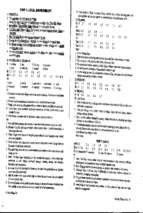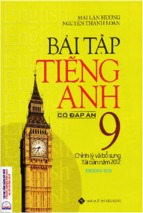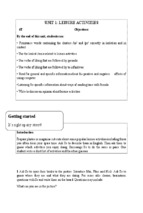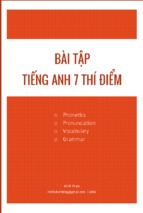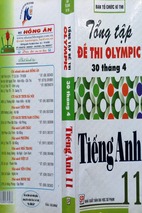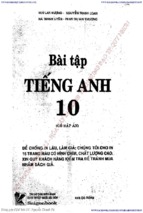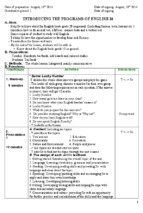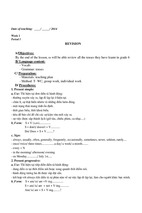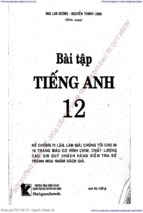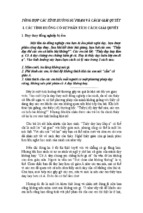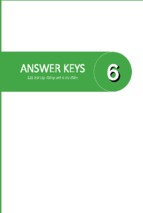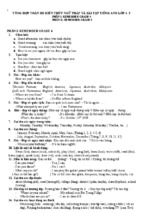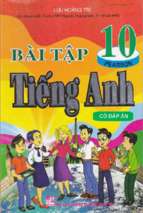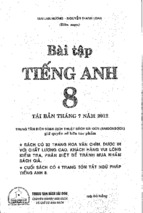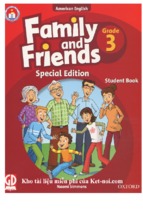GIÁO ÁN GIẢNG DẠY CHƯƠNG TRÌNH THÍ ĐIỂM MÔN TIẾNG ANH 10(2017-2018)
Date of preparation:
25/08/ 2017
Date of teaching: 28/8/ 2017
Period 1
INTRODUCING THE PROGRAMS OF ENGLISH 10
I. Objectives:
1. Knowledge:
Student know: - How to learn English in grade 10
- How to do English tests
- How to use student’s book and workbook
2. Main contents: Students know about English book in grade 10
3. Skill : - Reading
- Speaking
- Listening
- Writing
- Doing English tests
3. Attitude: Active to join activities and tasks in class
4. Orientation of ability development :self-taught, giving solutions, brainstorming,
managing, communicative and co-operative.
II/ METHODS, TEACHING TECHNIQUES, TEACHING ORGANIZATION AND
TEACHING AIDS:
-Methods: Integrated, mainly communicative
-Teaching techniques: discussion, open dialogue, report…
-Teaching aids: pictures, colored chalks, workbooks, handouts, sub-boards
III/ PROCEDURES:
1.Organizations: (1 minute)
Check the total of the class
2.Oral test : Nothing
3. New lesson:
Time/Stages
Teacher’s Activities
Students’activitie Achieved
s
competences
* Activity 1: Game: Lucky Number
Analytical
1. Warm-up
-T divides the whole class into two
thinking
groups and plays the game.
Group work
9 minutes
- The leader of each group chooses a
The leader of
number for their own group and does each group
the following requirement in each
chooses a number
question. If the answer is correct, they for their own
will get 10 marks.
group and does
1. Lucky Number
the following
2. How many girls are there in your
requirement in
class?
each question. If
3. Do you know what your English
the answer is
teacher’s name is?
correct, they will
4. Lucky Number
get 10 marks.
5. What do you prepare for this
TEACHER: LUU LAI THUY DUNG – TRAN QUOC TUAN HIGH SCHOOL
- PAGE 1
GIÁO ÁN GIẢNG DẠY CHƯƠNG TRÌNH THÍ ĐIỂM MÔN TIẾNG ANH 10(2017-2018)
semester?
6. Do you like studying English?
Why or Why not?
7. How do you learn English well?
8. Do you speak English fluently?
- T leads Ss in the lesson.
A.Activity 2: Content: Including six
2.
topics
Presentation 1 - T introduces the topics.
1. You and me
2.
Education
12 minutes
3. Community
4.
Recreation
5. Nature and Environment
6. People and places
--> Six topics are divided into ten
units.
- T asks Ss to find out the topic
through the unit’s name.
B. The design of each unit in
textbook:
1. Getting started: Introducing the
overall topic of the unit
2. Language: Learning vocabulary,
grammar and pronunciation
3. Reading: Developing reading skills
and providing Ss with language and
ideas about the topic
4. Speaking: Developing speaking
skills and encouraging Ss to apply and
share their own knowledge
5. Listening: Developing listening
skills
6.Writing: Developing writing skills
and helping Ss cope with ideas and
necessary language
7. Communication and culture:
providing Ss with an opportunity for
further practice and consolidation of
the skills and the language learnt
previously in the unit.
8. Looking back and project:
- Revising and consolidating of the
language in the unit
Analyzing
main
contents
THE WHOLE
CLASS WORK
- Listen to the
teacher
- Listen to T’s
explanation about
six topics
- Listen and take
notes in their
notebooks.
TEACHER: LUU LAI THUY DUNG – TRAN QUOC TUAN HIGH SCHOOL
- PAGE 2
GIÁO ÁN GIẢNG DẠY CHƯƠNG TRÌNH THÍ ĐIỂM MÔN TIẾNG ANH 10(2017-2018)
- Providing Ss with an opportunity to
apply the language and skills they
learnt throughout the unit to perform a
task in a realistic situation
- After 2 units, Ss have one period for
test themselves. It helps them test
themselves about what they’ve learnt.
C. Tests:
3.
1- Checking frequency knowledge for
Presentation 2 the previous lesson.
2- Fifteen minutes test (3 times for
20 minutes
each semester)
3- Forty minutes test (2 times for each
semester)
4- Semester test (Once for each
semester)
D. The new point in learning English
10
- Communicative method /approach.
- Task - based method /teaching.
- The book is designed with 4 skills.
- Complete and various tests.
- Learner - centered approach.
E. Introduce the English book grade
10
- Ask Ss to look through the book then
tell class how many units it has.
- Introduce some more information.
- There are 6 themes including You
and Me; Education; Community;
Nature and Environment; National
Parks; Recreation and People and
Places.
- There are 8 periods in each unit.
They are Getting Started, Language,
Reading, Speaking, Listening,
Writing, Culture and communication
and Looking Back
F. Some requires of students
- Read the lesson before studying in
class.
- Do all exercises at home.
- It is good to find the meaning and
the pronunciation of the new words in
Analyzing
main
contents
THE WHOLE
CLASS WORK
- Listen to the
teacher
- Listen to T’s
explanation about
six topics
- Listen and take
notes in their
notebooks.
TEACHER: LUU LAI THUY DUNG – TRAN QUOC TUAN HIGH SCHOOL
- PAGE 3
GIÁO ÁN GIẢNG DẠY CHƯƠNG TRÌNH THÍ ĐIỂM MÔN TIẾNG ANH 10(2017-2018)
the dictionary at home.
-Listen to the teacher attentively and
take part in the lesson actively and
creatively.
- Take part in the activities that the
teacher required such as pairs work,
group work or individual
- Each S has a notebook and book
(student book and work book)
4.
Consolidation
2 minutes
5. Homework
2 minutes
- Ask Ss to consolidate the main
contents.
- Give feedback.
THE WHOLE
CLASS WORK
- Listen to the
teacher
consolidatin
g
- Prepare the new words in Unit 1:
Family life
Lesson1: Getting started
V. DESCRIPTION OF FOUR AWARENESS LEVEL
Recognition
(30%)
Understanding
(40%)
Activity 1
Ss can give out
some words
Activity 2
Ss understand
the meaning of
new words
Ss can give out
the words and
understand
them clearly
Ss understand
the words and
ideas in the
passage
Content
High
application
(10%)
Ss understand
Ss can these
the combination words to give
among the
their opinion
words
Ss can use new Ss can answer
words to
the questions
answer the
and explain for
questions
them
Low application
(20%)
VI/ EVALUATING QUESTION:
- Review all of knowledge you’d learned in grade 9
(understanding).....................................................................................................................
..............................................................................................................................................
...................................................................................
Date of preparation:
Period 2
25/08/ 2017
Date of teaching: 28/8/ 2017
UNIT 1 FAMILY LIFE
Part 1: GETTING STARTED
TEACHER: LUU LAI THUY DUNG – TRAN QUOC TUAN HIGH SCHOOL
- PAGE 4
GIÁO ÁN GIẢNG DẠY CHƯƠNG TRÌNH THÍ ĐIỂM MÔN TIẾNG ANH 10(2017-2018)
I/objectives
1. knowledge
By the end of this unit, Ss can:
- Use lexical items related to the topic Family life
- Read for specific information about the benefits of sharing housework
- Exchange opinions about household chores
- Listen to understand a TV programme about roles performed by family members
- Understand different family lifestyles in different cultures
2. main contents: Students should know about home life
3. Skills: Guessing meaning in context, scanning for specific information and
passage comprehension
4. Attitude: sts can know the responsibity of helping parents with household
chores.
5. orientation of Competence development:
- General competences: communication, cooperation and study themselves.
- Specific competences: learn about the roles of women in society.
II/ METHODS, TEACHING TECHNIQUES, TEACHING ORGANIZATION
AND TEACHING AIDS:
-Methods: Integrated, mainly communicative
-Teaching techniques: discussion, open dialogue, report…
-Teaching aids: pictures, colored chalks, workbooks, handouts, sub-boards
III.PROCEDURES
1.Organizations: (1 minute)
Check the total of the class
2.Oral test : Nothing
3. New lesson:
Teacher’s activities
Achieved
competences
Students’ activities
Activity 1
Aim: To introduce the topic of the INDIVIDUAL WORK
unit, vocabulary about household Answer the question
chores and the grammar point Look at the picture and answer
taught in the unit.
the questions
Lead-in: (5ms)
- They are a family.
- T asks students if they often do
- The father is vacuuming the
housework and what housework
floor. The mother is cooking. The
each member of their family
son is washing dishes and the
does.
daughter is doing the laundry.
- Ask them to look at the picture
- Do as required.
and guess what they show.
- Ask students about the picture:
TEACHER: LUU LAI THUY DUNG – TRAN QUOC TUAN HIGH SCHOOL
Giving
solutions
- PAGE 5
GIÁO ÁN GIẢNG DẠY CHƯƠNG TRÌNH THÍ ĐIỂM MÔN TIẾNG ANH 10(2017-2018)
E.g. – Who are the people in the
picture?
- What are they doing?
Activity 2(10MS)
- T plays the recording. Asks
students to listen and read along
silently.
- Ask students to work in pairs to
decide whether the statements
are true (T), false (F), or not
given (NG). Have students refer
back to the conversation to give
reasons for their answers.
- T goes around and supervise.
- Then check their answers, and
give explanations.
Activity 3(10MS)
- T plays the recording and ask
students to listen and repeat the
words/phrases
Activity 4(10MS)
- Tell students to refer back to
the conversation to find the
verbs/ verb phrases that go with
the words/phrases in the
conversation.
- Play the recording again if
necessary.
- Ask students to pay attention to
words that are often used
together (collocations) then ask
them to give some examples.
Reading for
main idea
THE WHOLE CLASS WORK
Key Activity 2
1. F
4. T
2. NG
5. T
3. F
6. NG
- Read along
Household chores
Household finances
Heavy lifting
Laundry
rubbish
groceries
washing up
THE WHOLE CLASS WORK
Verb/Verb
Words/
phrases
Phrases
1 Split, divide,
(household)
handle
chores
2 Take out
Rubbish
3 do
Laundry
4 Shop for
Groceries
5 Do
Heavy lifting
6 Do
Washing-up
7 Be responsible
Household
for
finances
Identifing
and
pronouncing
the sound
IV. Consolidation(5MS): - Summarize the main points
V. Homework: (2MS)- Ask students to learn by heart new words and collocations in the
text.
IV/ LEVELS OF AWARENESS
1. Description of four awareness levels
High
Recognition
Understanding Low application
Content
application
(30%)
(40%)
(20%)
(10%)
TEACHER: LUU LAI THUY DUNG – TRAN QUOC TUAN HIGH SCHOOL
- PAGE 6
GIÁO ÁN GIẢNG DẠY CHƯƠNG TRÌNH THÍ ĐIỂM MÔN TIẾNG ANH 10(2017-2018)
Activity 1
Ss can give out
some words
Activity 2
Ss understand
the meaning of
new words
Activity 3
Ss know where
to find the
needed
information
Activity 4
Ss know the
answer
Ss can give out
the words and
understand them
clearly
Ss understand
the words and
ideas in the
passage
Ss understand
the questions
clearly and
giving the
information
Ss can answer
the questions
Ss understand
the combination
among the
words
Ss can use new
words to answer
the questions
Ss can answer
the questions
and finish the
task easily
Ss can present
their opinion
Ss can these
words to give
their opinion
Ss can answer
the questions
and explain
for them
Ss can finish
the task and
explain for
their answer
Ss can present
their opinion
and respond
to other ones’
ideas
V/ EVALUATING QUESTIONS
- Aks Ss to compare the family described in the text with your own family (basing on the
handouts).(low application)
Date of preparation:
25/08/ 2017
Date of teaching: 28/8/ 2017
Period 3
UNIT 1 FAMILY LIFE
Part 2: LANGUAGE
I/objectives
1. knowledge
By the end of this unit, Ss can:
- Use lexical items related to the topic Family life
- Pronounce consonant clusters /tr/, /kr/ and /br/ correctly in isolation and in
context
- Understand the present simple vs. the present continuous
- Understand different family lifestyles in different cultures
2. main contents: Students should know about home life
3. Skills: Guessing meaning in context, scanning for specific information and
passage comprehension
4. Attitude: sts can know the responsibity of helping parents with household
chores.
5. orientation of Competence development:
- General competences: communication, cooperation and study themselves.
- Specific competences: learn about the roles of women in society.
II/ METHODS, TEACHING TECHNIQUES, TEACHING ORGANIZATION
AND TEACHING AIDS:
TEACHER: LUU LAI THUY DUNG – TRAN QUOC TUAN HIGH SCHOOL
- PAGE 7
GIÁO ÁN GIẢNG DẠY CHƯƠNG TRÌNH THÍ ĐIỂM MÔN TIẾNG ANH 10(2017-2018)
-Methods: Integrated, mainly communicative
-Teaching techniques: discussion, open dialogue, report…
-Teaching aids: pictures, colored chalks, workbooks, handouts, sub-boards
III.PROCEDURES
1.Organizations: (1 minute)
Check the total of the class
2.Oral test : (5MS) check new words
3. New lesson:
Achieved
Teacher’s activities
Students’ activities
competences
Aim: To provide students with a right way
to pronounce some clusters and how to
Identifing and
distinguish present simple and present
pronouncing
continuous tense.
Activity 1: Vocabulary(15ms)
INDIVIDUAL WORK the sound
Task 1(5ms)
- Do as required
- Ask students to work individually, read 1.
f
5.b
the words and phrases in the box, then 2.
e
6.g
discuss and find the meaning for each of 3.
a
7.d
them (a-h).
4.
h
8.c
- Provide support if necessary by guiding
students to use the context of the
conversation to choose the meaning for
the words/ phrases.
Task 2(5ms)
- Ask students to work in pairs. Read the
conversation in GETTING STARTED
again and list all the household chores
that are mentioned in the conversation.
- Then elicit more chores to add to the
list.
Task 3(5ms)
- Have students work in pairs or groups to
ask and answer the questions.
- Encourage them to use the chores in the
list in their answers. Before working in
pairs, students may work individually.
- Ask students to read the list again and
write down who does each of the chores
in their families.
PAIR WORK
Chores from the
conversation:
- prepare dinner
- cook (do the cooking)
- shop
- clean the house
- take out the rubbish
- do the laundry
- do the washing-up
- do the heavy lifting
- be responsible for the
household finances
Other chores:
- mop/sweep/tidy up the
house
- bathe the baby
TEACHER: LUU LAI THUY DUNG – TRAN QUOC TUAN HIGH SCHOOL
Scanning
information
- PAGE 8
GIÁO ÁN GIẢNG DẠY CHƯƠNG TRÌNH THÍ ĐIỂM MÔN TIẾNG ANH 10(2017-2018)
- Check to make sure students use the - feed the baby
correct verbs/ verb phrases in the correct - water the houseplants
tense with the name of the chores.
- feed the cat/dog
- iron/fold/put away the
clothes
- lay the table for meals
- Work in pairs or
groups
- Read again and write
down
- Read the words
Activity 2 : Pronunciation(10ms)
Task 1(5ms)
-Play the recording and let students listen.
Play it again with pauses for them to repeat
each word.
Give the meaning of the words if
necessary. Help students distinguish the
three sound clusters.
- Ask students to work in pairs and take
turns reading the words in columns and in
rows. Then, invite individuals to read the
words in one or two rows.
TASK 2(5MS)
- Ask students to read the words in rows,
paying attention to the difference
between the sound clusters.
- Play the recording and have students
listen to the sentences and circle the
word they hear.
- Check students’ answers by asking them
to call out the letter (a, b or c)
corresponding to the word they hear.
THE WHOLE
CLASS WORK
- Listen to the tape
1. b
2. b
3. c
4. a
THE WHOLE
CLASS WORK
Key:
1. does
2. cooks
3. cleans
4. is watching
5. is doing
6. is doing
7. is tidying up
8. is trying
Identifing and
pronouncing
the sound
Activity 3 :Grammar(10ms)
TASK 1(5MS)
- Have students read the text individually
TEACHER: LUU LAI THUY DUNG – TRAN QUOC TUAN HIGH SCHOOL
- PAGE 9
GIÁO ÁN GIẢNG DẠY CHƯƠNG TRÌNH THÍ ĐIỂM MÔN TIẾNG ANH 10(2017-2018)
once and ask them to pay attention to the
words/ phrases such as every day, today,
at the moment, and ask them what verb
forms are often used in the sentences that
have these words/ phrases. Ask students
to choose the correct verb form.
- Ask students to work in pairs to compare PAIR WORK
their answers.
1. does, is not
- Check students’ answers and then elicit
cooking, is
from them the rules of using the present
working
simple and the present continuous.
2. is taking out
TASK 2(5MS)
3. cleans, is cleaning
- Have students work in pairs to give their
4. is preparing
answers.
5. looks after, works
- Observe and help when and where
6. is watching,
necessary.
watches
- Ask students to use the words/ phrases:
now, at the moment, usually, today, every
evening, etc. as clues for their answers.
- Check students’ answers by asking
individuals to take turns reading aloud
each of the sentences.
IV. Consolidation(3MS)
- Summarize the main points
V. Homework(2’)
- Ask students to learn by heart new words and collocations in the text.
- Ask students to review grammar part
VI. DESCIPTION ON THE COMPETENCES
Low
Recognition
Understanding
Content
application
(30%)
(40%)
(20%)
Activity 1
Ss can give out Ss can give out Ss understand
some words
the words and
the combination
understand
among the
them clearly
words
Activity 2
Ss understand
Ss understand
Ss can use new
the meaning of the words and
words to
new words
ideas in the
answer the
passage
questions
Activity 3
Ss know where Ss understand
Ss can answer
to find the
the questions
the questions
needed
clearly and
and finish the
TEACHER: LUU LAI THUY DUNG – TRAN QUOC TUAN HIGH SCHOOL
Solving
problems
High
application
(10%)
Ss can these
words to give
their opinion
Ss can answer
the questions
and explain for
them
Ss can finish
the task and
explain for their
- PAGE 10
GIÁO ÁN GIẢNG DẠY CHƯƠNG TRÌNH THÍ ĐIỂM MÔN TIẾNG ANH 10(2017-2018)
information
giving the
task easily
answer
information
Complete the sentences. Put the verb into the correct form.
1. Trees …………………more quickly in summer than in winter (grow)
2. We ……………………………at about 7.00. Couldn’t you come an hour late?
(usually/ get up)
3. Now he ……………………his last great work in Vienna. (write)
4. Alice ……………………..her mother in London most weekends. (see)
5. “Shall I phone at 6.00?” “No, I ………………..dinner at that time. ( cook)
Keys: 1. Grow
2. Usually get up 3. Is writing 4. Sees
5. Am cooking
Date of preparation:
Period 4
Date of teaching:
UNIT 1 FAMILY LIFE
Part 3: READING
I/objectives
1. knowledge
By the end of this unit, Ss can:
- Use lexical items related to the topic Family life
- Read for specific information about the benefits of sharing housework
- Exchange opinions about household chores
- Understand different family lifestyles in different cultures
2. main contents: Students should know about home life
3. Skills: Guessing meaning in context, scanning for specific information and
passage comprehension
4. Attitude: sts can know the responsibity of helping parents with household
chores.
5. orientation of Competence development:
- General competences: communication, cooperation and study themselves.
TEACHER: LUU LAI THUY DUNG – TRAN QUOC TUAN HIGH SCHOOL
- PAGE 11
GIÁO ÁN GIẢNG DẠY CHƯƠNG TRÌNH THÍ ĐIỂM MÔN TIẾNG ANH 10(2017-2018)
- Specific competences: learn about the roles of women in society.
II/ METHODS, TEACHING TECHNIQUES, TEACHING ORGANIZATION
AND TEACHING AIDS:
-Methods: Integrated, mainly communicative
-Teaching techniques: discussion, open dialogue, report…
-Teaching aids: pictures, colored chalks, workbooks, handouts, sub-boards
III.PROCEDURES
1.Organizations: (1 minute)
Check the total of the class
2.Oral test : (5MS) check new words
3. New lesson:
Teacher’s activities
Aims: to practice reading skills for the
students. They can also read and get the
general idea of a text; guess the meaning of
words in context; and make references when
reading a text.
Lead-in: Inform students of the lesson
objectives
Activity 1 : TASK 1(5’)
-Let students work in groups, look at the
picture and answer the questions. Ask
students to call out the answers to question 1
freely. For question 2, ask a representative
of each group to give the opinion of the
group.
Students’ activities
-
GROUP WORK
Work in groups
Look at the picture
and answer the
question
The answer can be:
Yes, they are. Because
they do the housework
together. /Because all
members of the family
share housework.
- Read the text
Activity 2: TASK 2(10’)
INDIVIDUAL WORK
- Have students read the heading (a-c) first.
Key c
Make sure that they understand all of them
and tell students that one of them is the title
for the text; they have to read the text and
decide which one it is.
- Ask students to read through the text once
without stopping at the words that they
don’t know the meaning of, and then ask
them to work in pairs to decide on the best
TEACHER: LUU LAI THUY DUNG – TRAN QUOC TUAN HIGH SCHOOL
Achieved
competences
Picture
description
Reading for
main idea
- PAGE 12
GIÁO ÁN GIẢNG DẠY CHƯƠNG TRÌNH THÍ ĐIỂM MÔN TIẾNG ANH 10(2017-2018)
title for the text. Remind students that the
title for the text is the one that gives the
general idea of the whole text.
- Check students’ answers and guide
students to the correct choice if necessary
by helping them eliminate the sentences
that are only about one aspect of the text.
PAIR WORK
Activity 3(10’)
Key
TASK 3(5’)
1. A
- Have students read the text again and
2. B
underline the words sociable, vulnerable,
3. B
critical, enormous and tend when they see
4. B
them on the text.
5. A
- Explain to students how to use context to
Key
guess the meaning of the unknown words
a. C
if necessary.
b. B
TASK 4(5’)
- Ask students to continue to work in pairs,
and find out what it refers to in each of the
sentences. Let students read and
understand the sentences before and after
the one that has the word in it to decide
what it means. Students can use the
elimination technique to give the right
answer.
GROUPS OF THREE
1. They do better at
school,
become
more sociable, and
Activity 4(15’)
have
better
TASK 5
relationships with
Ask students to work in groups of three,
their teachers and
ask them to read the questions first to
friends.
make sure they understand what
2. Because it shows
information they need in order to answer
that they care
the questions. It may help if students can
about their wives
underline the key words in the questions.
and this makes
For example:
their wives happy.
1. How do children benefit from sharing
3. They may fall ill
housework?
easily or may
2. Why do men tend to have better
think
about
TEACHER: LUU LAI THUY DUNG – TRAN QUOC TUAN HIGH SCHOOL
Make
references
communicativ
e
- PAGE 13
GIÁO ÁN GIẢNG DẠY CHƯƠNG TRÌNH THÍ ĐIỂM MÔN TIẾNG ANH 10(2017-2018)
relationships with their wives when
they share housework?
3. What may happen to women whose
husbands do not contribute to the
household chores?
4. How does the family benefit when
divorce.
everyone works together on household
4. There is a positive
chores?
atmosphere for the
Solving
- Then ask students to read the text again,
family.
problems
and locate the part of the text where they
can get the answer to each of the
questions before they discuss the
answers.
- Check students’ answers by inviting a
representative from each group to give
the answer to one of the questions. If the
students’ answer is incorrect, don’t give
the right one at once, but try to elicit it
from other students.
TASK 6
GROUPS OF FOUR
- Put students in groups of four and let
- Do as required
them discuss the questions freely. If
students have difficulty with ideas, give
them some examples of problems such
as problems with time, skills and
attitude.
- One or two groups to report the
discussion results to the class.
IV. Consolidation(3’): - Summarize the main points
V. Homework(2’): - Ask students to prepare for the next lesson.
VI. DESCIPTION ON THE COMPETENCES
Low
High
Recognition
Understanding
Content
application
application
(30%)
(40%)
(20%)
(10%)
Activity 1
Ss can give out Ss can give out Ss can give out Ss can give out
the answer
the answer
the answer
the answer
easily
easily
easily
Activity 2
Ss understand
Ss understand
Ss can use new Ss can use new
the meaning of the words and
words to
words fluently
new words
give ideas to
answer the
to make the
the task
questions
conversation
Activity 3
Ss know where Ss understand
Ss can answer
Ss can finish
TEACHER: LUU LAI THUY DUNG – TRAN QUOC TUAN HIGH SCHOOL
- PAGE 14
GIÁO ÁN GIẢNG DẠY CHƯƠNG TRÌNH THÍ ĐIỂM MÔN TIẾNG ANH 10(2017-2018)
to find the
needed
information
Activities 4
Ss know the
answer
the questions
clearly and
giving the
information
Ss can answer
the questions
the questions
and finish the
task easily
the task and
explain for their
answer
Ss can present
their opinion
Ss can present
their opinion
and respond to
other ones’
ideas
Questions :
HOUSEHOLD CHORE CHART
DAD
MUM
LAM
AN
Mending things , cleaning the bathroom
Do most of the cooking and groceries shopping
Doing the laundry, taking out the rubbish and
cleaning the fridge, laying the table for meals,
sweeping the house and feeding the cat (share with
sister)
Helping mum prepare meals and washing the dishes,
laying the table for meals, sweeping the house and
feeding the cat (sharing with brother)
Date of preparation:
Period 5
Date of teaching:
UNIT 1 FAMILY LIFE
Part 4: SPEAKING
I/objectives
1. knowledge
By the end of this unit, Ss can:
- Read for specific information about the benefits of sharing housework
- Exchange opinions about household chores
- Write about doing household chores in the family
- Understand different family lifestyles in different cultures
2. main contents: Students should know about home life
3. Skills: Guessing meaning in context, scanning for specific information and
passage comprehension
4. Attitude: sts can know the responsibity of helping parents with household
chores.
5. orientation of Competence development:
- General competences: communication, cooperation and study themselves.
- Specific competences: learn about the roles of women in society.
II/ METHODS, TEACHING TECHNIQUES, TEACHING ORGANIZATION
AND TEACHING AIDS:
-Methods: Integrated, mainly communicative
TEACHER: LUU LAI THUY DUNG – TRAN QUOC TUAN HIGH SCHOOL
- PAGE 15
GIÁO ÁN GIẢNG DẠY CHƯƠNG TRÌNH THÍ ĐIỂM MÔN TIẾNG ANH 10(2017-2018)
-Teaching techniques: discussion, open dialogue, report…
-Teaching aids: pictures, colored chalks, workbooks, handouts, sub-boards
III.PROCEDURES
1.Organizations: (1 minute)
Check the total of the class
2.Oral test : (5MS) check new words
3. New lesson:
Achieved
Teacher’s activities
Students’ activities
competences
Aims: To encourage students to talk about the
chores of their love and hate.
Lead-in:
- Pay attention to
Provide students with some handouts with
teacher and match
the names of household chores and ask
the chores with the
students to match the chores with
pictures.
corresponding pictures
Activity 1(10’)
Ask students to work by themselves,
write at least three household chores they
INDIVIDUAL
like and three they dislike doing in the
WORK
“Name of chore” column, then add a reason
Expressing
why they like or dislike the chore.
opinions
Call some of them to present the answers
- Do as required
orally.
Likes
Name of chore
Reasons
Feeding the cats and Love animals
dogs
Do the groceries
Like shopping
Taking out the
It is not too hard
garbage
Dislikes
Name of chore
Reasons
Laundry
Take much time
and quite hard
Washing the dishes
Often break things
PAIR WORK
Looking after the
Waste time, be
- Guess the answer
baby
tired
to each question.
ActIvity 2(10’)
Have students work in pairs. Ask them
to read all the questions in Anna’s column
TEACHER: LUU LAI THUY DUNG – TRAN QUOC TUAN HIGH SCHOOL
Communicativ
e
- PAGE 16
GIÁO ÁN GIẢNG DẠY CHƯƠNG TRÌNH THÍ ĐIỂM MÔN TIẾNG ANH 10(2017-2018)
first and underline the key words in each
question before asking them to guess the
answer to each question.
1. What household chores do you do
every day?
2. Which of the chores do you like doing
the most?
3. What do you like about it?
4. Which of the chores do you dislike
doing the most?
Encourage students to use the key
words as cues to find the answers in Mai’s
column to match with Anna’s questions.
Ask students to take turns being Mai
and Anna to practice the conversation
Anna: What household chores do you do
every day?
Mai: I do the laundry, wash the dishes, and
sweep the house. I sometimes do the cooking
when my mum is busy.
Anna: Which of the chores do you like doing
the most?
Mai: well, I think I like sweeping the house.
Anna: What do you like about it?
Mai: It’s not too hard, and I like seeing the
house clean after I sweep it.
Anna: Which of the chores do you dislike
doing most?
Mai: Washing dishes, because I often break
things when I do the washing-up.
- Work in pairs and
try to match the
columns
Cooperative
- Practice the
conversation
Key
1.c
2.a
3.d
4.b
-Work with a
different partner to
have a similar
conversation.
reporting
PAIR WORK
- Report to the class
Activity 3(10’)
Ask students to work with a different
partner to have a similar conversation.
Explain that this time they should talk about
themselves, and they have to find out what
chores their partner does, what chores
she/he likes or dislikes the most and why.
Tell students to use the questions in
activity 2 and the ideas in activity 1 to do
this activity.
TEACHER: LUU LAI THUY DUNG – TRAN QUOC TUAN HIGH SCHOOL
- PAGE 17
GIÁO ÁN GIẢNG DẠY CHƯƠNG TRÌNH THÍ ĐIỂM MÔN TIẾNG ANH 10(2017-2018)
Invite a student from one or two pairs
to report to the class what she/he has found
about his/her partner.
IV. Consolidation(3’): - Summarize the main points
V. Homework(2’): - Ask students to prepare for the next lesson.
VI/ LEVELS OF AWARENESS
1. Description four awareness levels
Content
Activity 1
Activity 2
Activity 3
Recognition
(30%)
Understanding
(40%)
Ss understand the Ss understand
meaning of new
the words and
words
ideas in the
passage
Ss know where to Ss understand
find the needed
the questions
information
clearly and
giving the
information
Ss know the
Ss can answer
answer
the questions
High
application
(10%)
Ss can use new
Ss can use new
words to answer words fluently
the questions
to describe the
picture
Ss can answer the Ss can finish
questions and
the task and
finish the task
explain for
easily
their answer
Low application
(20%)
Ss can present
their opinion
Ss can present
their opinion
and respond to
other ones’
ideas
EVALUATING QUESTIONS
Household chores
Date of preparation:
Period 6
Date of teaching:
UNIT 1 FAMILY LIFE
TEACHER: LUU LAI THUY DUNG – TRAN QUOC TUAN HIGH SCHOOL
- PAGE 18
GIÁO ÁN GIẢNG DẠY CHƯƠNG TRÌNH THÍ ĐIỂM MÔN TIẾNG ANH 10(2017-2018)
Part 5: LISTENING
I/objectives
1. knowledge
By the end of this unit, Ss can:
- Use lexical items related to the topic Family life
- Exchange opinions about household chores
- Listen to understand a TV programme about roles performed by family members
- Understand different family lifestyles in different cultures
2. main contents: Students should know about home life
3. Skills: Guessing meaning in context, scanning for specific information and
passage comprehension
4. Attitude: sts can know the responsibity of helping parents with household
chores.
5. orientation of Competence development:
- General competences: communication, cooperation and study themselves.
- Specific competences: learn about the roles of women in society.
II/ METHODS, TEACHING TECHNIQUES, TEACHING ORGANIZATION
AND TEACHING AIDS:
-Methods: Integrated, mainly communicative
-Teaching techniques: discussion, open dialogue, report…
-Teaching aids: pictures, colored chalks, workbooks, handouts, sub-boards
III.PROCEDURES
1.Organizations: (1 minute)
Check the total of the class
2.Oral test : (5MS) check the interview
3. New lesson:
Teacher’s activities
Aim: To equip students with more
knowledge about roles of men and women
in families.
Lead-in: Introduce the topic: write down
two words wife/woman- husband/man and
ask students to make two words webs
about the roles of wife/woman and
husband/man in the family. Students are
free to call out their answers and T writes
down the words in the web.
Activity 1(10’)
Ask students to work in pairs,
looking at the chart and discussing the
Achieved
competences
Students’ activities
PAIR WORK
- some new words and useful
expressions:
+the chart shows/presents/
illustrates……
+As can be seen from the
chart
+According to the chart
TEACHER: LUU LAI THUY DUNG – TRAN QUOC TUAN HIGH SCHOOL
Groups
Discussion
- PAGE 19
GIÁO ÁN GIẢNG DẠY CHƯƠNG TRÌNH THÍ ĐIỂM MÔN TIẾNG ANH 10(2017-2018)
general/generally
changes in the weekly hours of basic +In
housework by married men and married speaking
Keys: the chart illustrates
women in the USA between 1976 and
the average hours of
2012. Students don’t have to report the
housework per week done
exact number of hours men and women
by married women in
spend on doing housework. They can
comparison with married
just talk about the general changes.
men. In general,married
Encourage students to guess the
women do more housework
reasons for the changes. Ask them to call
than married men. The
out their guesses. Write the reasons
numbers
of
weekly
given by students on a corner of the
housework hours that men
board so that they can see if their guesses
and women do is 29 and 6.8
are correct later, after they listen to the
respectively.
it
takes
recording.
marrien women ….hours to
do housework whereas
married men spends …
Activity 2(10’)
hours doing housework
Tell students that they are going to
listen to a family expert talking about
how the roles of men and women in
families have changed. Ask them to read
all the statements and guess if they are
true or false. Make sure that students
INDIVIDUAL WORK
understand all the statements.
Listen carefully
Vocabulary
Key activity 2
Contribute to(v) make a great
1. T
contribution to
2. T
Recreation(n) (formal) fun, relax
3. T
after work
4. F
>< entertainmen(n) fun for
5. T
film,TV…
>< amusement(n) something you
like
Play the recording and have
students do the exercise. Check students’
PAIR WORK
answers.
Key activity 3
Activity 3(10’)
1.e
- Have students work in pairs to match
2.b 4.D
the words/ phrases with their
3.c 5.A
appropriate meaning. To help students
het the answers easily, ask them if they PAIR WORK
- Read the questions
TEACHER: LUU LAI THUY DUNG – TRAN QUOC TUAN HIGH SCHOOL
Listen for
specific
information
Identifying
new words
Solving
problems
- PAGE 20
- Xem thêm -

